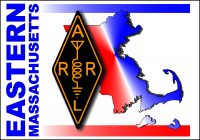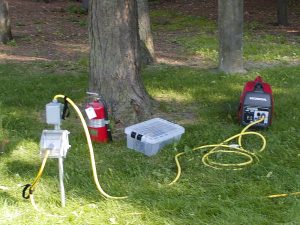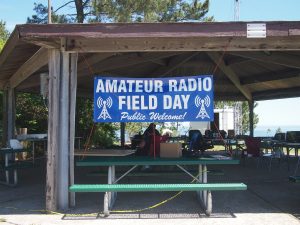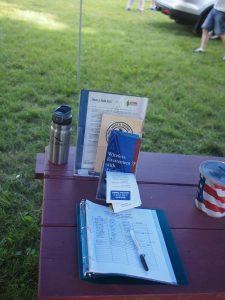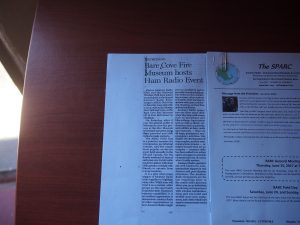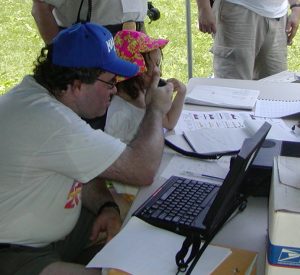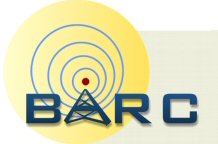NIMS (ICS) for Field Day Planning
The National Incident Management System (NIMS)
not just for Disasters any more
not just for Command any more
Many of the “served agencies” in our ARES work will be trained in, and use during emergencies, a common jargon and organizational structure called “NIMS” (or NIIMS; formerly called ICS). This is an outgrowth of experiences in California wildfire management, where firefighters and other emergency personnel from various agencies regularly have to work together in different groupings than they’ve drilled. Use of NIMS is now mandatory on all Fire departments and HazMat operations (including private sector!) has been adopted by FEMA and MEMA and increasing numbers of local Emergency Management Agencies (EMA’s).
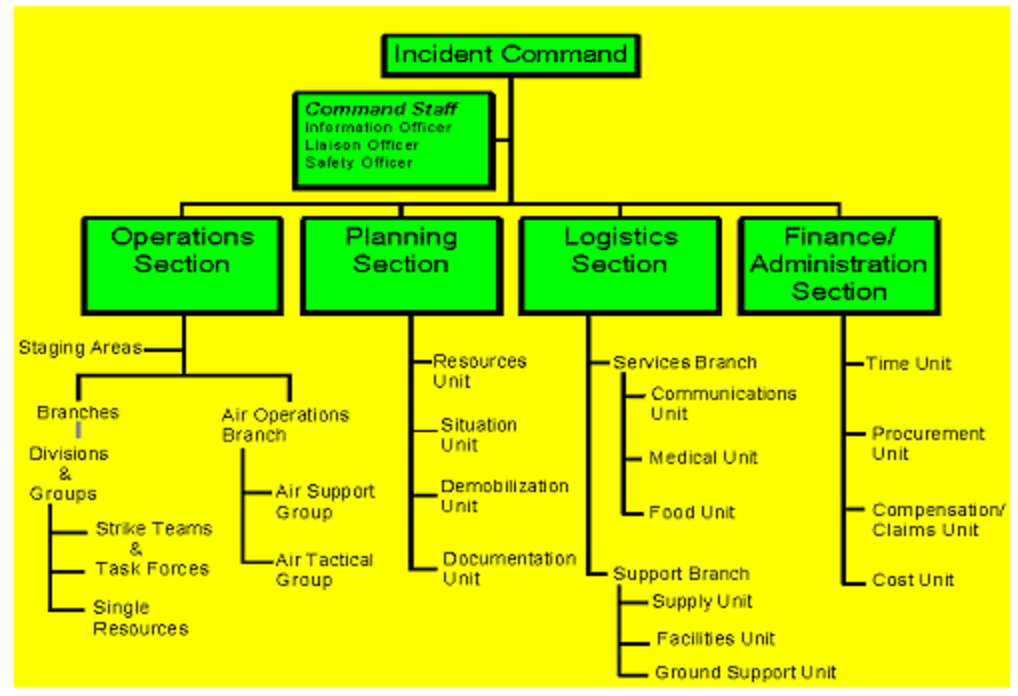
NIMS has been used for planning in advance and execution of non-emergency events. For instance, according to the FEMA trainer, Fidelity (the major Boston investment house) planned and executed it’s annual employee Christmas party (a pretty big event) using NIMS (which was a major success, and validated their use of NIMS for both business and environmental emergencies).
Incidents/Events that can Utilize the NIMS Incident Command System
- Fires, hazardous materials, and multi-casualty incidents.
- Single and multi-agency law enforcement incidents.
- Multi-jurisdiction and multi-agency disaster responses.
- Search and rescue missions.
- Oil spill response and recovery incidents.
- Air, rail, water, or ground transportation accidents.
- Planned events, e.g., celebrations, parades, concerts.
- Private sector emergency management programs.17-03-I402-SL
It will be easier for us to provide communications support to served-agencies’ operations if we are comfortable with their jargons and drills too. Indeed, demonstrated familiarity with their procedures and jargon may be necessary to get the foot in the door in some situations.
Training in NIMS is available through FEMA/MEMA, on the WWW, private-sector commercial training, and (unofficially) via ARES.
NIMS and Field Day Planning
Most clubs have a usual committee structure for their Field Day planning. The people planning and the people doing on Field Day are probably the same people — and are exhausted by the time to clean up and prepare the logs for transmission. Most clubs’ usual committee structures are probably — due to the structures of common sense — similar to the NIMS-inspired structure proposed below. Some clubs may even already have assigned clean-up/demobilization/after-FD roles, which are so useful to avoid volunteer burn-out. The major advantages predicted for using NIMS titles for your FD committees are (a) practice with the served-agency jargon; (b) emphasis on staffing by specific responsibility and in shifts; (c) remembering to plan and recruit for take-down and follow-up as well as the more glamorous set-up and operations.
A NIMS Structure for Field Day Planning & Operations
The following is offered as a customizable template, not a carved-in-stone one-true-way. Clubs should do what feels natural, don’t wreck your Field Day! But if they can migrate towards using NIMS terminology and structures in their major events such as Field Day and PSE’s (public service events), they’ll be better positioned to provide communications to events and emergency agencies using the NIMS. So feel free to edit the heck out this for your club, adjusting for how your club is comfortable dividing responsibility.
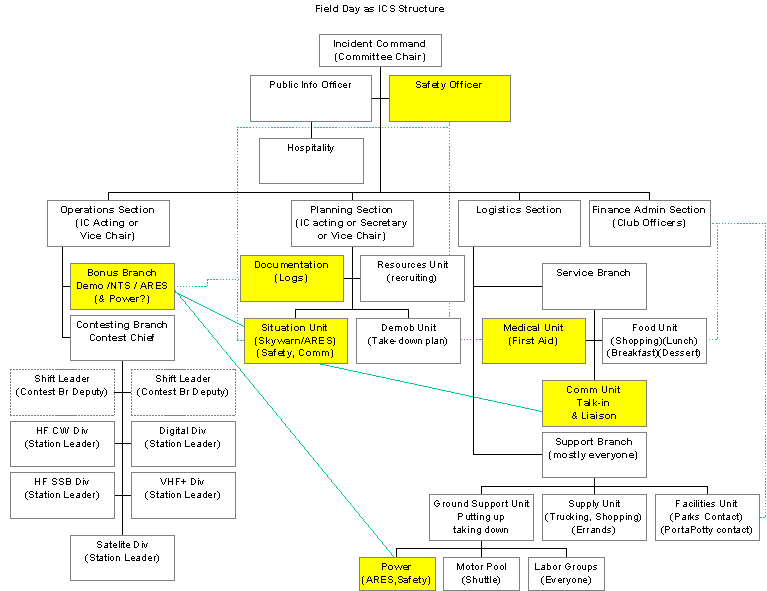
You don’t need a large bureaucracy to do this … One tenet of NIMS is that several conceptual levels of hierarchy can be internalized into one person. The person responsible for a function splits out only the sub-roles that need delegating: but the NIMSNames for the Roles let him/her quickly communicate to the various delegates who is doing what and make sure nothing is forgotten.
- Incident Commander = Field Day Chair
- Safety Officer — See KC1US’s FD Safety Officer memo and related Safety Posts and Weather Posts
- Information Officer / Public Relations = Public Information Officer (PIO)
- Press releases before
- Hospitality / Public relations at event
- Press releases after
- Might include VE Exam(*) or other public-service/member-service function.
(*) Question pools not infrequently change July 1, making Field Day a fun time for a last-chance test on the old study guides.
- Planning Section [Field Day Chair & committee; or, Planning Chief may be Committee Secretary]
- Situation Unit: Situation Supervisor may also be Site Safety Officer, or works closely with. Watching the fires; liason with Skywarn with Logistics/Services/Comm or just listening to NWS to track incoming weather. ARES Real-World / Homeland Security Liaison with Logistics/Services/Comm. Site security?
- Resources Unit (recruiting): Help other committees schedule people before FD. May utilize Talk-In (Logistics/Services/Comms) to recruit club members in real-time on Field Day.
- Demobilization Unit (takedown planning): Planning who/how to take it all down, and (via Logistics) get it all, and everyone, back to where they belong.
- Documentation: Preserve guest book, contest logs with Operations/Bonus Unit? May help plan logging process, process/submit logs afterwards?
- Logistics Section
- Service Branch
- Communications Unit (this is where we, ARES/RACES hams, usually fall within someone else’s NIMS operation!): Talk-in and any other non-contest comms operations, whether on radio/cell/internet, whether on ham, commercial or PS licensed, or part 15/FRS radios. Might include scoring the NTS points with/instead of Operations/Bonus Unit. Guard the usual repeaters, 146.52, and club simplex frequency for queries, provide communications Liaison with RACES / SKYWARN / ARES for Planning/Situation and Safety Officer, relay information for any Supply Also, set up wireless or wired internet access for Skywarn radar. unit and shuttle mobiles.
- Medical Unit: First Aid plan / focal-point; cooperate with Safety.
- Food Unit: (all important!) – Can break down into Planning & Shopping, Drinks, Snacks, Cooking, Breakfast, Dessert. Can leverage the Support Branch to find & move the stuff once a list & Budget are prepared.
- Support Branch
- Supply Unit: (truck-type transport; leg-work on purchasing for food and supplies; transporting borrowed equipment for other sections’ unfilled requirements, e.g. antenna tuner, and return!)
- Facilities Unit: (arrangements & interface with landlord/host; renting outhouses and other equipment; arranging borrowing of real estate and capital equipment based other sections’ unfilled requirements, e.g., generator.)
- General Ground Support
- General hands / Labor Details — everyone! (Antenna and tent raising, lugging)
- Shuttle & Errands Group (car-type or passenger-van-type transport for people: shuttle to public transit stop, last-minute shopping, pizza-run)
- Power Group runs the generator(s), charges batteries, manages available power. (does this fall under Facilities or General Ground? who cares, it’s Support! Once you’re operational, it’s the primary component of Support, along with errands & shuttles transport. Works with, may be combined with, Safety Officer & Operations-Bonus. This is a great place for the ARES hams, since they need Generator practice.)
- Service Branch
- Finance & Admin Section (club treasurer or Field Day treasurer; Frequently will be Club Treasurer and other Club officers handling their roles.)Club officials with spending authority; approve purchases based on club rules and FD budget.
- Time Unit – Can handle ARES Sign-in, although Planning: Documentation probably does that. In a PSE or activation, a Time Unit can tally up Volunteer hours for ARRL or Red Cross reporting. For Field Day, attendance logs fall under Operations/Bonus and Planning/Documentation, since we’re not Billing or estimating equivalent Donated time, but logging such may be good practice.
- Procurement Unit – Support for contracting with PortaPotty and other suppliers. Normally for ARES and Field Day, actually purchasing is delegated to Food or Logistics/Support/Supply, with Treasurer providing simple reimbursement. In a large deployment, Agency professionals will do real Purchasing and Supply will just pick it up.
- Operations SectionThis is where everyone thinks all the action is, but anyone who’s been through Field Day realizes half the fun is in the above, everything else.· Shift Leaders are Deputy Contest or Deputy Operations Chiefs who lead while the Chief sleeps, or who rotate main Operational leadership if the IC is “acting” as Ops & Contest Chief. In NIMS, Operations is divided into functional Branches as needed; with further geographic or functional Divisions or Groups, as needed. Most of our functional Divisions can naturally be called “Stations”.
- Contesting Branch (Contest Chief; Plus Shift Supervisors who act as Chief)Each Station counted in your 7-Alpha Field Day class would be one “Division” or “Group” for NIMS purposes, both for planning and operations. Most clubs probably have a pre-existing idea of what equipment is required for each station and usually where to get it. Under NIMS, a Station Captain can ask for Logistics / Support / Supply assistance in getting loan (or purchase, if approved) for items that it’s own staff can’t loan or borrow from customary sources. [See more detail below.]
- HF SSB Division Station (Station leader; shift operators, shift loggers)
- HF CW Division (ditto)
- VHF+ Division(s) (ditto)
- Digital Division(s) (ditto)
- Satellite Division (ditto)
- Shift Leaders are Deputy Contest or Deputy Operations Chiefs who lead while the Chief sleeps, or who rotate main Operational leadership if the IC is “acting” as Ops & Contest Chief.
- … see Field Day Scoring thoughts
- Bonus Branch &/or ARES Branch = Emergency Coordinator or AEC, or NTS Net Manager, or …In using NIMS, the club ARES unit can be made responsible for many of the Field-Deployment exercises of Field Day, in particular, Logistics (getting and keeping running the generator). However, the “contest” part of Field Day has many aspects that, while they belong in Operations, are still more ARES-like, in particular, the bonus points some of may cross into other NIMS Divisions, but may be included in Bonus Branch and/or ARES Branch:
- Operations
- Ensuring power is according to operating class, i.e., emergency power.
- Handling NTS traffic (for points)
- Any other special points available (satellite or digital if no station?)
- Making Natural Power contacts (for points)
- Demo points
- Logistics
- Services – Communications·
- Sending SM/SEC radiogram (for points) (Communications)
- NTS origination/delivery could be Communications too.
- Real-world Liaison-– Skywarn, ARES, Homeland Security. (Also Services – Communications)
- Support – Power · Operating as Power-management Group under Logistics above
- Services – Communications·
- Planning: Documentation or Admin: Time
- Taking role call / check-in of ARES-enrolled members present (for SM/SEC radiogram)
- Checking that PIO is logging visitors
- Setting up and Preserving Contest station logs
- Planning: Situation
- Safety (With Safety Officer)
- Real-world Liaison-– Skywarn, ARES, Homeland Security. (Also Services – Communications)
- Operations
- Contesting Branch (Contest Chief; Plus Shift Supervisors who act as Chief)Each Station counted in your 7-Alpha Field Day class would be one “Division” or “Group” for NIMS purposes, both for planning and operations. Most clubs probably have a pre-existing idea of what equipment is required for each station and usually where to get it. Under NIMS, a Station Captain can ask for Logistics / Support / Supply assistance in getting loan (or purchase, if approved) for items that it’s own staff can’t loan or borrow from customary sources. [See more detail below.]
- Safety Officer — See KC1US’s FD Safety Officer memo and related Safety Posts and Weather Posts
Contest Chief & Shift Supervisors
The Contest Chief may have Shift Supervisors to spell him/her on the Line. They should ensure operations conform to FCC and contest regulations, to protect the club’s score & reputation and the license trustee. The Contest Chief or Shift Supervisor is responsible for seeing that there is a Control Operator of appropriate license grade supervising each station in use.
One particular concern for contest regulations to monitor is ensuring that the number of transmitters in use never exceeds the number permitted by the contest class, including ensuring that no two transmitters are under the same exemption at once. Some clubs have used physical Tokens for each counted and exempted transmitter, others expect active coordination with the Chief/Supervisor; others may fudge but that is not appropriate in a NIMS operation! [comments]
Station Leader works with Planning/Resource-Recruiting to schedule operators & loggers; with Logistics to acquire (and return!) the equipment; and likely with the Contest Chief & Shift Supervisors during Operations.
Caution!
Reading through the online documentation and training on NIMS and using a NIMS inspired committee structure is only the beginning. Please do not claim your Field Day was 100% NIMS compliant just because you use the above outline as a committee template. This will set rather higher expectations in your local Emergency Management Agency than you would be ready to fill, unless all your Section and Branch chiefs have already been through FEMA-approved intermediate NIMS training!
However, if the Field Day chair and one or more Section Chiefs (particularly Planning section chief if separate) had attended IS-100, the introductory NIMS training workshop, or worked through the online equivalent materials, others have seen the A.R.E.A. NIMS course, and others were signing up for the next NIMS offerings, you’d be well on your way.
Resources
A short “Introduction to the Incident Command System for Amateur Radio” was published back before the federal rename to NIMS by a Michigan Fire Chief. Aside from the change from ICS to NIMS name, it is still mostly correct and is not a bad first read.
See the Emergency Communications section and your local ARES EC (or RACES / EMDirector as appropriate) for more resources, including training schedules.
Bill Ricker, N1VUX (formerly EC & DEC Boston & Training; currently editor EMA FD Directory)
Originally written for FD2000, updated periodically
